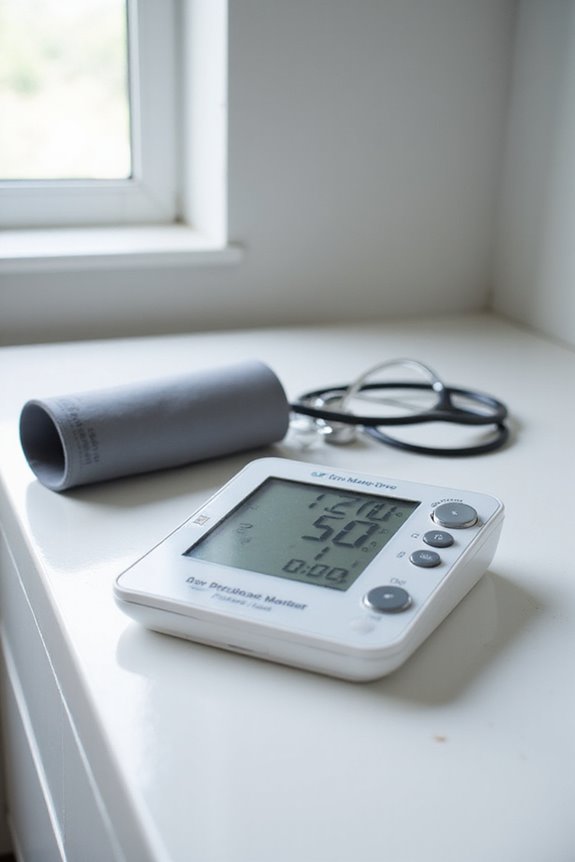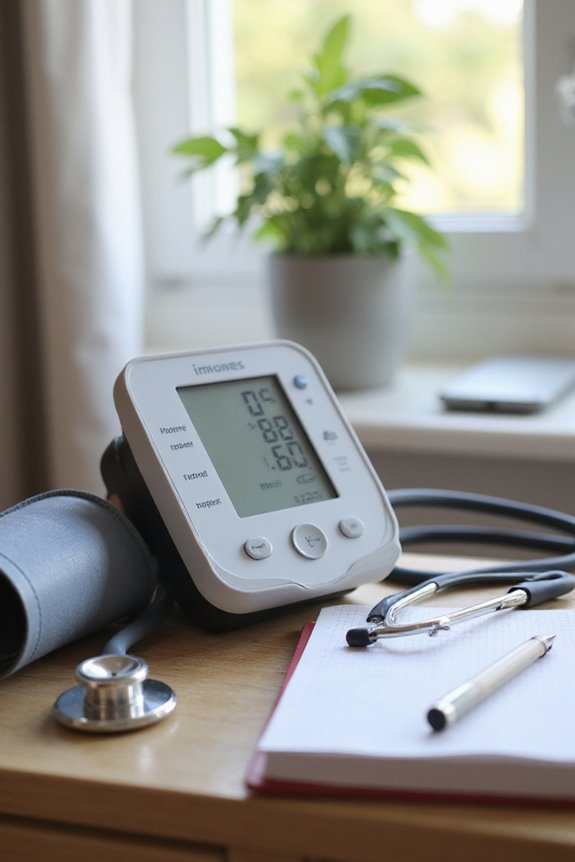Blood pressure monitoring measures the force of blood against arterial walls. It consists of two readings: systolic pressure, taken during heartbeats, and diastolic pressure, measured between beats. Accurate monitoring allows for the identification of hypertension and related cardiovascular risks. Common techniques include auscultatory and oscillometric methods. Devices used range from digital monitors to ambulatory systems. Regular monitoring is critical for effective management of health conditions. Further insights are available on the implications of these measurements.
Key Takeaways
- Blood pressure monitoring involves measuring systolic and diastolic pressure to assess cardiovascular health.
- Regular monitoring helps identify individuals at risk for hypertension and related diseases.
- Various techniques, including auscultatory and oscillometric methods, are used for accurate readings.
- Digital monitors are popular for home use due to their ease of operation and memory features.
- Consistent monitoring aids in early detection, management, and prevention of serious health complications.
Understanding Blood Pressure
Understanding blood pressure is essential for recognizing cardiovascular health and managing potential risks associated with hypertension. Blood pressure, measured in millimeters of mercury (mm Hg), consists of two readings: systolic and diastolic.
- Systolic Blood Pressure: The top number, representing pressure during heartbeats.
- Diastolic Blood Pressure: The bottom number, indicating pressure between beats.
Blood pressure categories include:
- Normal: <120/80 mm Hg
- Elevated: 120-129/<80 mm Hg
- Stage 1 Hypertension: 130-139/80-89 mm Hg
- Stage 2 Hypertension: ≥140/≥90 mm Hg
Measurement methods, such as manual sphygmomanometers and digital monitors, provide critical data for evaluating these levels. Elevated or high blood pressure may lead to severe health issues, necessitating regular monitoring for informed health management. Using a Bluetooth Blood Pressure Monitor enhances convenience and accuracy in tracking blood pressure readings.
Importance of Monitoring Blood Pressure

Monitoring blood pressure is a crucial aspect of maintaining overall health, as it provides essential data for evaluating cardiovascular risk and managing hypertension.
Reduces Cardiovascular Risk
Regular monitoring aids in identifying individuals at risk for cardiovascular diseases, enabling early intervention.
Enhances Diagnosis
Self-measured blood pressure monitoring provides accurate readings, improving hypertension diagnosis outside clinical settings.
Improves Management
Consistent monitoring effectively manages blood pressure, minimizing the risk of heart attacks and strokes.
Community Initiatives
Promoting blood pressure awareness through community initiatives can lead to significant reductions in cardiovascular events.
Cost-Effectiveness
Home monitoring is cost-effective, associated with moderate decreases in blood pressure, ultimately reducing long-term healthcare costs. Additionally, the convenience of wireless blood pressure cuffs makes it easier for individuals to track their readings regularly.
Techniques for Blood Pressure Measurement

Various techniques exist for blood pressure measurement, each with distinct applications, advantages, and limitations.
- Invasive techniques involve direct measurement via intra-arterial catheters, offering continuous monitoring and real-time accuracy, primarily in critical settings.
- Auscultatory techniques, the traditional standard, utilize a sphygmomanometer and stethoscope to detect Korotkoff sounds, requiring skilled personnel for reliable results.
- Palpatory assessments provide a quick estimate of systolic pressure by feeling the radial artery, useful in emergencies but lacking diastolic values.
- Oscillometric devices automate measurements by analyzing arterial vibrations, suitable for home and clinic use, though accuracy can vary; measurement accuracy is often validated through clinical testing for credibility.
- Continuous non-invasive methods like volume clamp and tonometry enhance monitoring without occlusion, improving patient comfort while still needing validation for clinical reliability.
Devices for Blood Pressure Monitoring

Blood pressure monitoring devices play an essential role in the management of cardiovascular health, particularly for individuals with hypertension. Various types exist, including:
- Mercury Column Monitors: Traditional but less common due to environmental concerns.
- Aneroid Monitors: Mechanical design, less popular than digital models.
- Digital Monitors: Widely used, featuring memory storage and clear displays.
- Wrist Monitors: Convenient but typically less accurate than arm monitors.
- Ambulatory Monitors: Track blood pressure over extended periods in clinical settings.
Key monitor features include cuff size for accurate readings, irregular heartbeat detection, and connectivity options. Device comparisons reveal differences in ease of use, cost, and patient preferences. Accurate devices meet validation criteria, ensuring reliable readings essential for effective hypertension management. Additionally, the choice of cuff size options is crucial for ensuring accurate blood pressure readings.
Health Implications of High Blood Pressure

High blood pressure, often referred to as hypertension, poses significant health risks that extend beyond the cardiovascular system. Approximately 1 in 3 adults worldwide suffer from hypertension, which is the leading risk factor for heart disease and stroke, responsible for half of all related deaths.
Key Health Implications:
- Increases risk of heart failure by overwhelming the heart.
- Can cause kidney damage, leading to chronic kidney disease.
- Often undetected until serious complications arise, highlighting the need for hypertension awareness.
- Contributes to irregular heartbeats, elevating the risk of sudden death.
- Effective management requires regular blood pressure monitoring, which aids in early detection and prevention.
Effective management and prevention are critical for maintaining cardiovascular health and reducing the economic burden linked to untreated hypertension. Early detection through regular monitoring remains essential to mitigate these risks.
Lifestyle Factors Affecting Blood Pressure
Lifestyle choices play a significant role in the management of blood pressure, impacting overall health and well-being. Key factors include:
- Dietary Habits: High sodium intake elevates hypertension risk. Conversely, adequate potassium, fiber, and protein consumption can lower it.
- Physical Activity: Regular exercise, including aerobic and resistance training, is vital for maintaining healthy blood pressure and weight.
- Substance Use: Tobacco and excessive alcohol increase blood pressure. Quitting smoking and moderating alcohol intake are essential for risk reduction.
- Stress Management: Chronic stress contributes to higher blood pressure; effective management strategies can mitigate this.
- Sleep Quality: Irregular sleep patterns and shift work are linked to hypertension risk.
- Environmental Influences: Exposure to pollution can negatively impact blood pressure levels.
Additionally, using a reliable ambulatory blood pressure monitor can help individuals track their blood pressure trends effectively.
These factors collectively shape cardiovascular health.
Frequently Asked Questions
How Often Should I Measure My Blood Pressure at Home?
Amidst the ebb and flow of daily life, home monitoring beckons; ideally, measurement frequency should span seven days, capturing the heart’s rhythm—yet three days may suffice when time or resources wane, ensuring wellness remains within reach.
Can Stress Affect My Blood Pressure Readings?
Stress greatly impacts blood pressure readings, with anxiety effects leading to immediate increases. Effective stress management is essential, as both acute and chronic stress can result in sustained elevation, affecting overall cardiovascular health and well-being.
What Time of Day Is Best for Measuring Blood Pressure?
The best times for measuring blood pressure are during a morning routine and evening habits. Consistent monitoring during these periods helps capture accurate readings, reflecting daily fluctuations and enhancing overall health management.
Should I Take Blood Pressure Medication Before Measurement?
Before measuring blood pressure, the timing of medication is essential. Dosage considerations play a significant role, as taking medication beforehand can influence readings. This careful approach fosters a sense of belonging to a supportive health community.
How Do I Interpret My Blood Pressure Readings?
Interpreting blood pressure readings involves understanding blood pressure categories and recognizing reading patterns. Regular monitoring helps individuals identify their status, enabling them to take proactive steps toward healthier living within their community and support networks.




